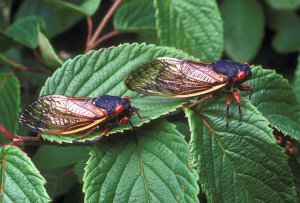An Introduction to the 17 Year Cicada:
Magicicada septendecim or as some would like to call it The 17 year cicada is one of the largest cicada species around. As it’s name states, it lives to about 17 years which is exceptionally long for any insect specimen.

Places where you can spot the 17 Year Cicada:
The Cicada usually lives underground and may only come out when it has gone through it’s nymph stage. You are more likely to find them in places with an abundance of trees where the young of the cicada may feed during their developmental phase until they become adults.
Physical Appearance:
The eyes of this cicada variant are big, beady and red while the rest of it’s body including it’s thorax is black. The veins on it’s wings also have a red hue about them though some may have them to be more orangish in color. They also sport orange stripes under their abdomen as well.
Distribution and importance:
This Cicada has quite an interesting life cycle. The nymph of this species live under the ground for around 17 years in which they feed and while going through various stages of metamorphosis finally emerge from the ground. They have a habit of making a lot of noise when they’re up on the surface.
Brood X:
There is also quite an infamous brood of these cicadas by the name of Brood X (also called the Great Eastern Brood). It is in present in the eastern part of the United States and is comprised of three species which include Magicicada cassinii, Magicicada septendecim and Magicicada septendecula. It is predicted that they will emerge in 2038.
They have emerged through countless periods of history including the 1700’s, 1900’s and now the 2000’s with every emergence being some sort of grand spectacle albeit a noisy one. The most recent emergence was in 2021. There have been cases where the brood may have emerged a bit too early but those are few in number.
Brood X has drawn attention from various forms of Media including but not limited to music, radio and even presidential addresses. They have also been mentioned in graphic novels as well.
The role of the 17 Year Cicada in Cooking:
Like most other insects, Cicadas can be cooked as well. Roast them or boil them, they do seem to have a decent flavor all around.
Some have said that Cicadas more or less have a nutty or rather buttery flavor. In general they consider them to be quite palatable. Perhaps one could even fry them with a butter and some garlic and eat them on some toast just like they do with escargot in France.
The Medicinal Uses of the 17 Year Cicada:
- Cicadas have been used in traditional Chinese Medicine for quite some time now. Their shell is (which they eventually shed) is ground and later prepared for various remedies.
- Once the nymph of a Cicada leaves it’s yellowish brown shell the herbalists get to work.
- Some have claimed that it may have some sort of antipyretic effect which can come in handy when it comes to treating fevers, tiredness, the flu and more.
- Skin treatment is also another thing that it may be used for. Rashes and other related skin conditions alike may be treated and eased by it.
- There have also been claims that it may treat pink eye as well via a preparation mixed with chrysanthemum flowers.
- It may also be used for remedying unwanted muscle spasms and other neurological issues as well.
- All in all, these “remedies” are merely based off of speculation. There is perhaps close to no scientific evidence to support these claims.
Health and Safety:
Though no side effects have been associated with it’s medical preparations. However, there have been reports of some Cicada preparations interacting with prescription medication.
Go to this link to check out other healthy insects:
https://eattheplanet.org/coconut-grub-bacon-without-the-pig/
To learn more about Brood X you can go to:
https://entomologytoday.org/2021/08/12/2021-brood-x-periodical-cicada-emergence-recap/
Many of our readers find that subscribing to Eat The Planet is the best way to make sure they don't miss any of our valuable information about wild edibles.
See our privacy policy for more information about ads on this site






